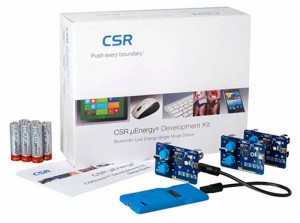The energy savings that can be made by switching to LED lighting in the home are well known. It has been widely documented that low power, high efficiency LED luminaires can reduce power consumption by more than 80% when compared to traditional sources, such as halogen and incandescent. Less well understood is the fact that smart lighting controls can shave significantly more off the electricity bill. Smart control features, made possible through sensors and wireless networks, include automatic dimming, and turning off lights in unoccupied rooms.
The market for smart lighting controls, increasingly being installed as part of a home automation system, is considered to be a huge opportunity within the broader Internet of Things (IoT) movement. However, the key to market growth is easy and flexible configuration and installation, as well as low cost and a fast payback on investment.
This article will consider some of the control strategies and wireless networking protocols suitable for domestic applications, focusing on newer alternatives to the established ZigBee Light Link. These include proprietary protocols, such as Thread and CSRmesh technology.


Figure1: A typical intelligent home lighting system using both Wi-Fi and ZigBee technology, retrofittable using wireless technology and controllable via a smartphone or tablet. (Source: ChipSip)
ZigBee benefits
For some years, ZigBee Light Link has been regarded as the protocol of choice for smart lighting in the home, and has begun to amass a sizeable installed base. ZigBee has a number of advantages over alternative network strategies for home automation. It is established, proven, well supported and dedicated to low power sensing and control applications that demand low latency. Importantly, it is designed to support a mesh network topology, allowing alternative routes between controllers and nodes. This is essential for a flexible and scalable system, such as domestic lighting, that requires centralized, automatic, and programmable controls, as well as remote and manual ‘point’ controls.
However, as IoT initiatives gain ground, the baseline is changing. The challenge is centered on the diversity of devices and their power sources that need to be connected within the IoT. A critical factor is the near ubiquitous use of smartphones and tablets as control devices, and the need to connect via Wi-Fi, IPv6 or Bluetooth. In this scenario, ZigBee Light Link is considered to be less able to leverage advanced communications networks such as 3G and 4G.
As a result, alternative protocols, as well as a new iteration of ZigBee 3.0, are emerging. Some of these new generation protocols are claimed to provide a better match specifically for lighting control within the growing demands of the IoT movement, both for domestic as well as industrial/commercial illumination applications.
Strong Thread
A strong new contender in the home networking domain is Thread, now supported by more than 160 companies and led by giants including ARM, Freescale, Samsung, Google (Nest) and more recently, Qualcomm. The protocol was officially launched in July with certified products just beginning to emerge.
This wireless mesh networking protocol stack, based on IEEE 802.15.4, supports multiple IP-based application protocols, including 6LowPAN or IPv6. A key benefit of Thread is secure connection to a low power mesh network with direct internet and cloud access for every device.
Thread is a self-healing mesh network scaling to 250+ devices, offering security via encryption; simple connectivity via a smartphone, tablet or computer; and low power, including support for battery-operated devices. Another advantage is that Thread supports mobility, such as if nodes in an IoT network are moving or moved about the house, intranet forwarding paths are automatically and constantly updated.
Not only is Thread based on the same protocol as ZigBee, but also the Thread Group has announced a collaboration with the ZigBee Alliance to enable ZigBee Cluster Library to run over Thread networks. While the two groups remain independent, they both see the importance of providing application level standardization. However, Thread is designed to support many different application layer protocols.
Developers wanting to learn more about the capability of Thread right now can invest in the EM35X mesh networking development kits fromSilicon Labs. The 30-day license, EM35X-DEV or full stand-alone Cortex-M3 license version for the IAR embedded workbench for ARM,EM35X-IAR, are available from Digi-Key. After registering the kit online with Silicon Labs, users can download and install the Thread Networking Software Stack. A wide range of online training modules is available online on the Silicon Labs website.
Bluetooth Smart Mesh
Showing some early promise, but generating some criticism from the established (mesh network) players, is CSRmesh, based on Bluetooth but adding a mesh topology. Introduced by CSR, it is regarded as a rival to Thread. However, CSR was recently acquired by Qualcomm, which clearly illustrates how many of the major players are backing multiple apparently competing protocols.
CSR is deeply involved in the Bluetooth Smart Mesh Working Group, which is expecting to announce its specification later this year to allow prototyping to start, with an official adoption in 2016. Although the current CSRmesh protocol is unlikely to be adopted wholesale, and may require some software tweaking later, a range of products is already available from CSR, including RF transceivers, receivers, subsystems, antennas and accessories, as well as evaluation and development kits. The ecosystem is growing too, with additional products emerging from a number of third party suppliers.
Bluetooth, while ideal (and popular) for connecting smart devices, including wearables, has not been considered appropriate for lighting controls or home automation in general. Not only is it primarily designed as a point-to-point cable rather than a multipoint network connection, but it also suffers from high overheads and high latency, lack of range and poor persistent control connection.
However, by adding Bluetooth Smart Mesh connectivity, CSRmesh is claimed to overcome many of these barriers, extending the range of Bluetooth and enabling connection to a virtually unlimited number of devices. Significantly, it is aimed squarely at lighting applications as well as home and building automation.
It is claimed to be easy to install, avoiding the need for pairing, and does not need a hub or access device such as a router to operate locally. Nodes can be configured and controlled with existing tablets or smartphones. Security is ensured through an encrypted network key, and other security measures can be implemented to prevent eavesdropping and attacks.
In addition, CSRmesh is designed for very low power consumption, using short messaging and ready to run on the lowest power microcontrollers and wireless networking chipsets. It provides support for ‘sleepy’ nodes: battery-operated and energy-harvesting powered devices can be grouped together with a mains-powered proxy device to relay information without waking the sensor. The same technique can also ensure network coverage in areas where RF cannot reach without relays.
The technology is expected to appeal to developers looking at lighting-centric but wider-ranging home automation solutions. Lighting control is a primary target, as it is widely regarded as the catalyst application to broader based home automation systems. For this reason, wireless networks need to be scalable to cover other applications, such as heating, air conditioning, door locks and window sensors, with varied performance and power requirements.
A good starting point to analyze the potential of CSRmesh and how it works with Bluetooth Smart is with development boards and kits. These kits provide a simple development platform and rapid prototyping solution. The DK-CSR1010-10184-1A CSRmesh Development Kit, for example, contains three target boards, USB-SPI programmer, connecting cables, batteries and a set-up guide. Example host applications and source code for smartphones, supporting both Google Android and Apple iOS are available.


Figure 2: The CSRmesh Development Kit provides an easy introduction and rapid prototyping solution for lighting control using Bluetooth Smart Mesh technology.
The development board (DB-CSR1010-10185-1A) can be purchased on its own. Based on the CSR1010 IC, the board contains board antenna, LED, pushbutton and slide switches, power switch, SPI programming connector, battery holders and pads to connect I/O to external devices.
ZigBee moves on
Meanwhile, ZigBee is moving forward in response to the IoT movement and the demand to interconnect a wider variety of smart devices that can interoperate seamlessly. The latest standard, ZigBee 3.0, expected to be ratified imminently, is based on ZigBee PRO. It unifies ZigBee Home Automation, ZigBee Light Link, ZigBee Building Automation and others. End devices certified to ZigBee Home Automation 1.2 and ZigBee Light Link 1.0 will be forward compatible with ZigBee 3.0.
A differentiating factor between ZigBee 3.0 and Thread lies with IP-based messaging. Thread is said to provide native support for IP, while ZigBee 3.0 is ‘fully IP compatible’, connecting to the internet via a router, gateway or set-top box. All devices in a Thread network have an IPv6 address, can be accessed directly by local devices, and connect externally via thread-capable IP routers, called Border Routers.
Interoperability is the key
In conclusion, most pundits agree that one single networking protocol is unlikely to suit the interconnection of all types of smart devices in a complex IoT application. Current thinking is that Wi-Fi, mesh networking and Bluetooth technologies will all be required concurrently. A single networking protocol is unlikely to evolve which will adequately support all applications, while maintaining efficiency, nor, even if it did, would it be adopted universally.
Systems designers will, for many years to come, continue to have to assess the merits and disadvantages of the various options and protocol combinations available according to the constraints and aims of individual projects. Energy efficient lighting, for example, may well require the lowest power mesh network supporting energy harvesting nodes, yet for ease of use, needs to be controlled via a smart phone or similar device.
Interoperability is the key. The fact that many vendors are now providing support for multiple networking and communications protocols could, hopefully, ensure greater compatibility between disparate technologies, ensuring choice for the developers without putting a brake on market growth due to standards uncertainty.
https://www.digikey.com/en/articles/techzone/2016/jan/mesh-networks-help-save-energy-through-smart-led-lighting-controls-in-the-home







